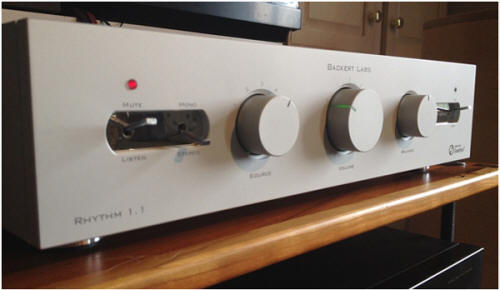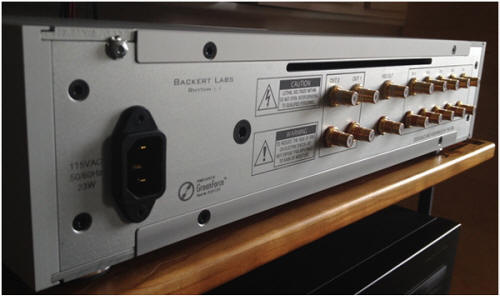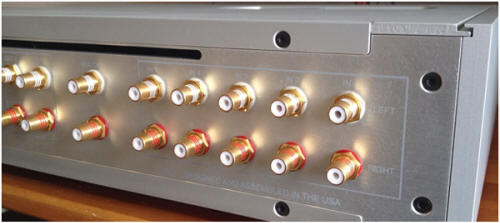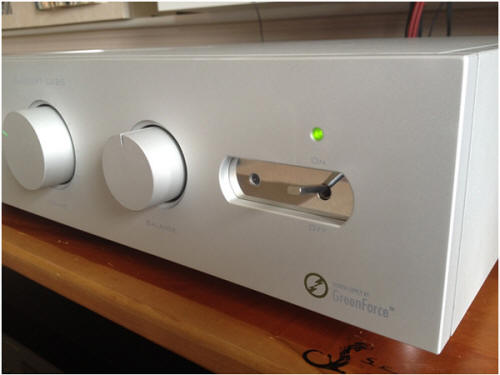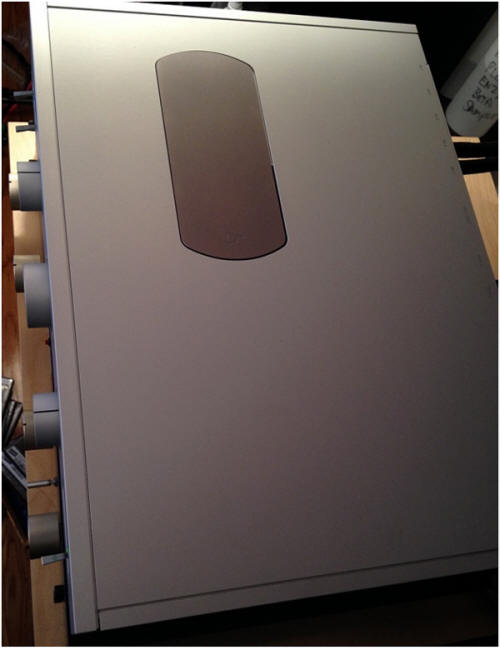|
|
You are reading the older HTML site
Positive
Feedback ISSUE 76
backert labs Rhythm 1.1 Linestage as reviewed by Michael Wechsberg
I'm excited to tell you about this great new tube line stage from Backert Labs based in Hockessin, Delaware near Philadelphia. This is, I believe, the first product from this new company headed by Bob Backert, who has been working magic modifying tubed equipment, especially preamps, for decades. Backert has a separate company called RHB Sound Dezign (not misspelled – see www.rhbsound.com) that you can contact if you want to check out his modifications. According to what I read on the internet, Backert has a good reputation for improving some of the already-good Conrad Johnson preamps of yore, among others. Over the years Backert developed some of his own techniques to enhance the coherency, clarity and rhythmic drive of preamp sound, characteristics that are also near and dear to my heart. Much of his work focuses on capacitors and power supply design. He tries to eliminate capacitors where possible, and where he can't, use only the best sounding types. Backert asserts his preamp is the first without a single aluminum electrolytic capacitor inside. This is not easy to pull off. In fact Backert has received several patents for his unique circuit design approaches that you can read about on his web site. Backert Labs was formed to bring all of Bob Backert's ideas for achieving the best preamp sound together into a product under his own name. By my ears he has succeeded in bringing to market an affordable preamp that does everything right, but puts the enjoyment of music front and center. Backert named his new prodigy the Rhythm 1.1 to emphasize his focus on getting the rhythm and timing parts of music right. Some others call this "drive" or "pace" but no matter what you call it if it ain't right you're missing something when you listen to your stereo rig. The Rhythm 1.1 is a beautiful beast, befitting its $7500 price tag, which is not cheap but not outrageous either. My sample had a classy frosted silver finish with matching knobs, but it's also available in black with polished silver knobs. The chassis is very nicely crafted but without some of the heroic features and finishes of the über-expensive preamps out there. The only bolts holding the chassis together are on the back, with no visible fasteners on the front or sides. On the left of the front panel are two good quality toggle switches housed inside a cutout. One switch is for muting the preamp and has an indicator bulb above it, and the second is a mono/stereo switch, a welcome feature. Next to the two toggles is a rotary switch to select among the five line-level inputs. A smoothly operating volume knob is next and it too has a light to show it's setting. I barely used this knob as I adjusted volume from the hefty remote control, which is its only function. To the right of the volume knob is a balance control. Finally, on the right of the front panel is an on/off toggle switch with a light, also contained within a rounded cutout similar to the one on the left for a balanced layout. The rear panel of the Rhythm 1.1 has 5 sets of inputs on gold-plated Vampire RCA jacks. Alas, no balanced inputs. There are two sets of variable outputs and a single set of fixed outputs for recording, also RCA's. The back panel also has a standard jack for a supplied power cord but I used Kubala-Sosna and Wywires power cords I had around and with which I am thoroughly familiar.
A unique feature of the Rhythm 1.1 is the push-to-open door on top of the chassis that allows easy access to the two tubes, both 12AU7s. The unit ships with JJ tubes and I found no reason to change them. Backert Labs Marketing Director Andy Tebbe did supply me with two sets of alternative NOS tubes but I never got around to tube rolling because of my personal schedule and backlog of reviews. The preamp design contains an autobias circuit that automatically adjusts the bias according to need. Although common in many tube power amp designs, this is quite unusual in a preamp. Backert says presence of the autobias circuit tends to reduce audible effects of different tubes but I was unable to confirm this. It is good to know that changing tubes for whatever reason, even replacing a worn out tube, should have a negligible impact on the sound. Here are some of the published preamp specifications:
Really impressive are the low noise and wide frequency response. I found the preamp to be dead silent and quieter than my reference tube preamp (I did experience an issue with hum in my system but it was due to my other equipment and not to the Rhythm 1.1). Some of the dynamic and transient performance I talk about later is enabled, I'm sure, by that wide frequency response. I should mention that Backert recalled the first sample of the preamp they sent me in order to make a change in the gain. They have reduced the gain in all current production based on another review that complained the gain was too high. I didn't have any such problem in my system with either of the two samples; both sounded identical (except for small change in gain).
Let's talk about some of the unique traits of the Rhythm 1.1. First, it uses a Greenforce™ power supply, patented by Bob Backert in 2013. This is a form of a linear regulated supply that provides current in a faster and more linear way than a conventional power supply that uses capacitors to store charge. With Greenforce™ Backert is able to use just 0.5% of the capacitance of a conventional preamp power supply, therefore, making it possible to use the best sounding film type capacitors in the supply and not a single electrolytic. The small number and value of capacitors required by this design also helps make the preamp more affordable. Backert seems to have a particular dislike of electrolytics both from a sonic and environmental standpoint (the latter opinion is probably why his innovative alternative is called "Green"). Indeed if you look inside the Rhythm 1.1 (I did not open up my sample but pictures are available on the web) it is relatively sparse compared to other preamps (including my EAR 868) partly because the large capacitors are missing. Backert has picked only the best sounding capacitors throughout the preamp and I'm sure a not insignificant amount of the cost of the preamp is due to these expensive devices. The Rhythm 1.1 "uses polypropylene capacitors in every position that handles the music signal: V-Cap™ polytetrafluoroethylene capacitors for the power supply, Tantalum capacitors for the filament/heater supply, and polypropylene capacitors for the regulator". The Greenforce™ power supply coupled with elimination of electrolytics is said to enable the preamp's outstanding clarity, dynamics and rhythmic drive. The Rhythm 1.1 operates in class A with no feedback, either local or global. The gain stage is called the "JB Gold" gain stage. Its features include use of constant current for the tubes, said to provide more linear amplification; active management of tube bias that automatically adjusts the bias to be optimum as tubes age or if a tube is replaced; active output correction that monitors the preamp output and corrects it back to the pure output of the tubes. This is said to compensate for any effect of the inductance and/or capacitance of the interconnects or variations in power amplifier impedance. In addition, the Rhythm 1.1 dispenses with use of a cathode follower output to lower output impedance. Backert feels the cathode follower can impair the fidelity of the preamp's dynamics so he does without it. This does mean that the preamp inverts phase so it is best to switch the positive and negative leads on your speakers when using this preamp.
Overall the Rhythm 1.1 has a very personal and unique design focused on bringing out the best musical rhythm and pace coupled with clear and linear operation. Let's see how successful this approach is. Setup I inserted the Rhythm 1.1 into my system consisting of the E.A.R. 890 amplifier and Marten Django XL speakers fronted by a Townshend Rock 7 turntable with Helius Omega tonearm and Decca London Reference cartridge, and an E.A.R. Acute 3 CD player/DAC. I kept my E.A.R. 868 preamp in the system used only as a phono preamp so it was connected to the Rhythm 1.1 via the fixed tape monitor output. The EAR 868 costs slightly more than the Rhythm 1.1 in today's dollars but it does include a phono stage with high-quality step-up transformers built in to handle moving coil cartridges. Power cords were a combination of Kubala-Sosna Emotion and Harmonic Technology cords that I've found optimum over the past couple of years. I used a Kubala-Sosna Emotion power cord for most of my listening with the Rhythm 1.1. All power cords, except for the turntable cord were plugged into a Wywires Power Broker. Speaker cables were my reference Kubala-Sosna Emotion cables. I placed the Rhythm 1.1 on my Marten equipment rack that is made of a very hard wood with lightweight shelves fashioned from a graphite composite. The shelves sit on spongy supports that help to absorb mid to high frequency vibration energy. Choosing interconnects for this review entailed a journey. I normally use balanced interconnects in my system (Kubala-Sosna Elation) except for the phono stage that uses a Wywires cable. Although I've reviewed numerous single-ended cables in my day I guess I did not keep many of them, because when I looked around the house to hook up the all single-ended Rhythm 1.1 I didn't have many choices. I did what I could and after some break-in time (Backert supplied the preamp already fully broken in) sat down to listen. Although I heard some great things I was not very happy with the sound and suspected the interconnects were to blame. I won't mention the brand of interconnects in fairness to the manufacturer as they are long discontinued and were far from top-of-the-line. To deal with this dilemma I approached Joe Kubala of Kubala-Sosna and Alex Sventitsky of Wywires for the loan of a set of single-ended interconnects. Joe came through with an already broken-in set of their top-of-the-line Elation cables, and Alex cooperated with a brand new set of then top-rated Platinum series cables (Wywires recently announced their Diamond series that is said to supersede the Platinum cables at the top of the brand). Either set of cables has a list price substantially more than the cost of the preamp.
I started with the Kubala-Sosna cables. Since I normally use the balanced version of these cables I was not surprised to hear an overall tonal signature similar to what I listen to every day with my E.A.R. 868 preamp. Really deep and juicy lows, a mellow yet pristine midrange, and shimmering highs with delicious detail. Later, after breaking in the Wywires cables for a while with the Rhythm 1.1, there was a noticeable shift in the tonal balance in favor of the highs. Lows were still extended but less fulsome, while the midrange remained clear and airy, the highs took on even more detail and clarity. But, the basic nature of the sound remained the same with either set of cables so I was now satisfied I could assess the Rhythm 1.1's sound without compromise from the cables. I mostly used vinyl LPs as a source for my evaluations but I did listen to a few CDs to check on some specific sonic characteristics. Listening The first thing that jumps out at you when listening to the Rhythm 1.1, and jump is a good word for it, is its speed and dynamic flow. When called for by the music the Rhythm 1.1 just seems to be a hair faster, especially at the leading edge of transients, than other preamps I've listened to. This extra speed gives an impression of increased dynamic range. This effect was more evident with the Wywires cables than with the K-S cables but was present with both. Music of all types had a palpable coherency, a feature I always listen for when I form an opinion of a component. Some very detailed preamps, and the Rhythm 1.1 is capable of revealing the smallest details, allow you to sonically dissect and separate the various instruments in an ensemble, but I find this can detract from enjoyment of the music. Often the emotional response to music hangs on how the various instruments and singers blend together in a coherent fashion to push the notes forward. It's one of the main reasons I bought the EAR 868 preamp and I found the Rhythm 1.1 to be cut from the same cloth. It does not distract you by pulling the musical performance apart, but instead it draws you into the performance by stitching it all together and moving it on, like running water. My experience is that this trick is difficult to pull off successfully, and requires a lot of things to be done right. It is characteristic of the better electronics available and I would place the Rhythm 1.1 in that class. From what I read, Bob Backert feels that his preamp extracts great rhythmic pace out of the music by eliminating many of the high value noxious capacitors present in most other preamps. Maybe. The E.A.R. 868 performs very similarly in this area yet it is chock full of capacitors and many more electronic components as well (two more tubes, input transformers, multiple power supply stages, etc.). This shows that there can be more than one way to get to audio nirvana. No matter how he gets there Backert has come up with one of the most tuneful and engaging preamps I have ever heard. Tonally the Rhythm 1.1 was a bit of a chameleon in my system depending on which set of interconnect cables I used as I've already mentioned. With the Kubala-Sosna cables it took on what might be considered by some a typical tube amplifier sound. With the Wywires cables the tonal balance was a bit lighter, more like a great solid-state amplifier, still with a sweet midrange but a little less warmth. As mentioned earlier, Backert uses active output correction to try to compensate for variations in cable characteristics. I'm not sure I can say this was effective in my system, but it might be with a different set of electronics and cables. Despite these differences the good qualities of this preamp shone through no matter what I played or which gadgets I deployed to enhance the musical experience. Apart from the outstanding dynamics and rhythmic flow already mentioned the comment that comes up most often in my listening notes for the Rhythm 1.1 is the stable imaging and distinct musical lines. With some components the position of a singer or instrument within the sound space can move around slightly as the music moves up and down the scale. I never heard this happen with the Backert preamp. Everything stayed rock solid and in one place which helped me follow the lyrics and the musical lines and to distinguish among multiple vocalists or instruments in an ensemble. Also helping in this regard was the superior detail portrayed by this preamp, especially at the low end of the dynamic range or at soft levels, and over the entire audible frequency range. This low level detail contributed to the intense feeling of drama this preamp gave to some music. It was hard not to get drawn into the music in an emotional way while listening to the Backert. Because, while the low level detail was great, the Rhythm 1.1 can also sound big, big, big when called upon, and by this I don't only mean loud, but also big in the portrayal of space. The Rhythm 1.1 was capable of rendering a wide and deep soundstage and it did an above average job revealing the acoustic signature of a space, heard during quiet spots or fades. It did not mess up the reverberation captured in a recording as is often the case in poorer components. The real message here is that the Rhythm 1.1 has superior clarity, transparency and linearity compared to many other preamps, even some well above its price range. It will bring out the best that your stereo system is capable of reproducing. The Rhythm 1.1 benefitted from many of the tweaks I threw at it. It has the resolution to reveal small differences that can sometimes change a good stereo system into a great one. For example, about half the time I listened to the Rhythm 1.1 sitting on its own feet on my good quality stereo rack. After a while I decided to try some footers underneath the unit to see if it could benefit from a different level of vibration control. I was not prepared for the subtle, yet very noticeable change wrought when I inserted some wooden footers from Stein Music under the preamp. Just about everything improved: tighter bass, wider soundstage, improved clarity, etc. All things that were already good got better. When I tried some metal footers from another manufacturer the opposite happened and the music got more murky. I have experience trying many types of so-called tweaks and I know it takes a system with superior resolution to really benefit from them. It says less about the particular type of tweak and more about the quality of the basic electronics you are tweaking. In summarizing the sound of the Rhythm 1.1 let me talk about my experience listening to a special LP that I own: a test pressing from the recent Acoustic Sounds re-issue of the RCA Living Stereo "The Reiner Sound." First, the entire recording, as heard through the Rhythm 1.1, has an amazing sense of drama that draws you into the music. The sound stage is wiiiiide and deep and the portrayal of the hall sound stands out. Dynamic contrasts are tremendous and when the music gets loud it has outstanding bone-rattling slam. At the same time the resolution at low levels is superior allowing you to hear every note and subtle detail. The overall tonal presentation is spot on with a boiling and detailed low end and an unfettered high end with no hint of harshness. It just seems like there are little or no electronics between the cartridge and the speakers. The Rhythm 1.1 is a tremendous bargain in the high end for its sound, but it faces much competition currently in the $6000 to $9000 price range for preamps with several new designs announced recently as well as great older designs still available. My own EAR 868 is in this range and it has the advantage of offering both balanced and single-ended operation and an outstanding MC/MM phono stage built in. Another example is the Zesto Leto preamp that is also a linestage and has received good reviews in PF and elsewhere. I certainly haven't heard all the competition but the Rhythm 1.1 holds its own among this breed with a wonderful clear and dynamic sound and awesome rhythmic drive, plus a look and mechanical design befitting its price. It's hard to understand why anyone would spend more for a preamp. If shopping for a new preamp I strongly encourage you to get in touch with Backert Labs and arrange for an audition. Michael Wechsberg
Backert Labs Rhythm 1.1 Line Stage
Backert Labs |










